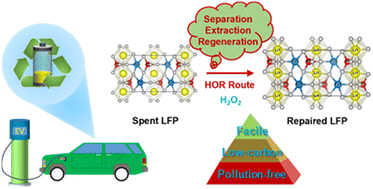In this study, we proposed a sequential and scalable hydro-oxygen repair (HOR) route consisting of key steps involving cathode electrode separation, oxidative extraction of lithium (Li), and lithium iron phosphate (LiFePO4) crystal restoration, to achieve closed-loop recycling of spent LiFePO4 batteries. A hydro-oxygen environment (with a cathode electrode : H2O2 ratio of 30 g mL−1) was first used to achieve nondestructive separation of the LiFePO4 cathode material and aluminum foil within a short period of time (0.25 min). The selective and high-efficiency extraction of Li from exfoliated LiFePO4 cathode materials was subsequently achieved by mechanochemically coupled oxidation potential regulation (conditions: 10 min, a rotational speed of 1000 rpm, and a LiFePO4 cathode material : H2O2 ratio of 1 : 37.5 g mL−1). The LiFePO4 crystals were successfully restored via a solid phase sintering process using the extracted Li and residual iron phosphate framework, and the regenerated LiFePO4 crystal exhibited a considerable specific electrochemical capacity (∼151.2 mA h g−1, 1C), which is comparable to that of commercial cathode materials. A life cycle assessment demonstrated that the HOR route can significantly reduce carbon emissions by −0.38 kg CO2 eq. and smog release by −0.17 kg O3 eq. per kg of spent LiFePO4 batteries, thus contributing to a circular economy and global decarbonization.
